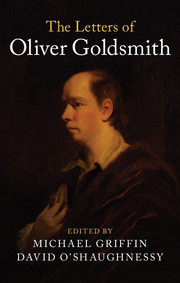44 - To Hugh Percy, Duke of Northumberland, London, 22 May 1772
Summary
Hugh Percy, Duke of Northumberland (bap. 1712, d. 1786) began life as Hugh Smithson. He was elected MP for Middlesex in 1740 and, in the same year, he made an advantageous marriage to Elizabeth Seymour (1716–76), who shortly after became heir to the Percy estates in Middlesex and Northumberland. Smithson succeeded to the title in 1750 and took the Percy name by an Act of Parliament. A number of honours followed and, after astutely exploiting the coal resources of his lands, he became extremely wealthy. The 1760s saw him hold a number of other offices including – of particular relevance to Goldsmith – the lord lieutenancy of Ireland (1763–5). Percy's wealth meant that he was not consumed by politics and the acquisition of high office and he pursued other interests. He was Fellow of the Royal Society as well as a trustee of the British Museum. A patron of the arts, he was acquainted with Johnson, Goldsmith and his namesake Thomas Percy, who stayed with him at Alnwick Castle regularly in his capacity as chaplain and secretary, as well as tutor to his son. He died at Sion House in 1786 and was buried at Westminster Abbey.
The copy-text is the manuscript in the British Library. It was first published by Balderston in 1928 which suggests that Thomas Percy secured this note from the duke for his Memoir but ultimately decided to omit it.
Mr. Goldsmith presents his most respectful compliments to the Duke of Northumberland, and as his Grace was pleased to allow him the liberty, he begs permission for a few friends some day next week to see his Grac[e's cast]le at Sion.
Temple. May 22d. 1772.
- Type
- Chapter
- Information
- The Letters of Oliver Goldsmith , pp. 108Publisher: Cambridge University PressPrint publication year: 2018



